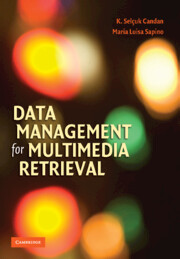Book contents
- Frontmatter
- Contents
- Preface
- 1 Introduction: Multimedia Applications and Data Management Requirements
- 2 Models for Multimedia Data
- 3 Common Representations of Multimedia Features
- 4 Feature Quality and Independence: Why and How?
- 5 Indexing, Search, and Retrieval of Sequences
- 6 Indexing, Search, and Retrieval of Graphs and Trees
- 7 Indexing, Search, and Retrieval of Vectors
- 8 Clustering Techniques
- 9 Classification
- 10 Ranked Retrieval
- 11 Evaluation of Retrieval
- 12 User Relevance Feedback and Collaborative Filtering
- Bibliography
- Index
- Plate section
3 - Common Representations of Multimedia Features
Published online by Cambridge University Press: 05 July 2014
- Frontmatter
- Contents
- Preface
- 1 Introduction: Multimedia Applications and Data Management Requirements
- 2 Models for Multimedia Data
- 3 Common Representations of Multimedia Features
- 4 Feature Quality and Independence: Why and How?
- 5 Indexing, Search, and Retrieval of Sequences
- 6 Indexing, Search, and Retrieval of Graphs and Trees
- 7 Indexing, Search, and Retrieval of Vectors
- 8 Clustering Techniques
- 9 Classification
- 10 Ranked Retrieval
- 11 Evaluation of Retrieval
- 12 User Relevance Feedback and Collaborative Filtering
- Bibliography
- Index
- Plate section
Summary
Most features can be represented in the form of one (or more) of the four common base models: vectors, strings, graphs/trees, and fuzzy/probabilistic logic-based representations.
Many features, such as colors, textures, and shapes, are commonly represented in the form of histograms that quantify the contribution of each individual property (or feature instance) to themedia object.Given n different properties of interest, the vector model associates an n-dimensional feature vector space, where the ith dimension corresponds to the ith property. Thus, each vector describes the composition of a given multimedia data object in terms of its quantifiable properties.
Strings, on the other hand, are commonly used for representing media of sequential (or temporal) nature, when the ordinal relationships between events are more important than the quantitative differences between their occurrences. As we have seen in Section 2.3.6.4, because of their simplicity, string-based models are also used as less complex representations for more complex features, such as the spatial distributions of points of interest.
Graphs and trees are used for representing complex media, composed of other smaller objects/events that cannot be ordered to form sequences. Such media include hierarchical data, such as taxonomies and X3D worlds (which are easily represented as trees), and directed/undirected networks, such as hypermedia and social networks (where the edges of the graph represent explicit or implicit relationships between media objects or individuals).
When vectors, strings, trees, or graphs are not sufficient to represent the underlying imprecision of the data, fuzzy or probabilistic models can be used to deal with this complexity.
- Type
- Chapter
- Information
- Data Management for Multimedia Retrieval , pp. 99 - 142Publisher: Cambridge University PressPrint publication year: 2010

